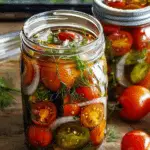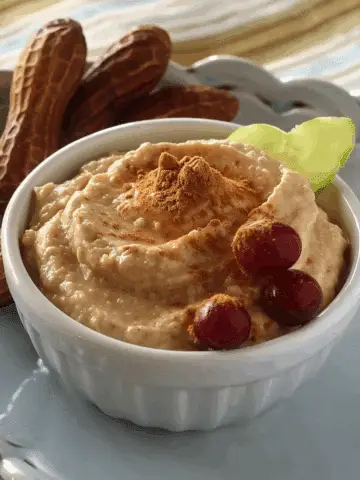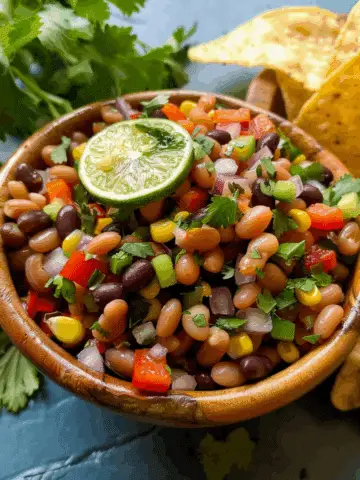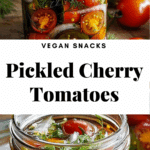Sweet and tangy pickled cherry tomatoes bursting with juicy flavor and perfect for snacking, salads, or a gourmet charcuterie board. These quick refrigerator pickles transform ordinary cherry tomatoes into delightful flavor bombs that will elevate your meals and impress your guests.

Why You'll Love This Recipe
These pickled cherry tomatoes are a game-changer for your culinary repertoire. They're incredibly versatile, adding a bright pop of flavor to salads, sandwiches, or enjoyed straight from the jar. The pickling process enhances the natural sweetness of tomatoes while infusing them with aromatic herbs and spices. With just minutes of active preparation, you'll create a gourmet condiment that stores beautifully in your refrigerator for weeks. They're also naturally vegan, gluten-free, and low in calories, making them a healthy addition to nearly any diet. Perfect for preserving summer's bounty or transforming store-bought tomatoes into something special year-round.
Ingredients
(Tip: You'll find the full list of ingredients and measurements in the recipe card below.)
Cherry tomatoes serve as the star of this recipe, providing a perfect sweet-tart base that holds up well to pickling while maintaining their juicy interior. Choose firm, ripe tomatoes for best results.
White vinegar creates the acidic environment needed for pickling and contributes to the bright, tangy flavor. It's widely available and provides the perfect sharpness.
Water dilutes the vinegar to create a balanced brine that isn't overwhelmingly sour.
Sugar balances the acidity of the vinegar and enhances the natural sweetness of the tomatoes. It dissolves into the brine, helping create that perfect sweet-tangy profile.
Sea salt not only seasons the pickles but helps to draw moisture from the tomatoes, allowing them to better absorb the flavors of the brine. The minerals in sea salt add subtle complexity.
Garlic cloves infuse the brine with aromatic depth. When smashed, they release more of their essential oils and flavor compounds.
Black peppercorns provide gentle heat and earthy notes that develop more fully as the pickles mature.
Red pepper flakes offer optional heat that can be adjusted to your preference or omitted entirely if you prefer a milder pickle.
Mustard seeds add tiny pops of flavor and subtle heat when they burst in your mouth. They're a classic pickling spice that brings complexity.
Fresh dill contributes its distinctive grassy, anise-like flavor that pairs beautifully with the acidity of pickles.
Bay leaf imparts subtle aromatic notes that round out the flavor profile of the brine and adds depth to the finished pickles.
Directions
- Wash and dry the cherry tomatoes. Using a toothpick or skewer, prick each tomato once to help the brine penetrate.
- Pack the tomatoes into a clean glass jar, layering in garlic, peppercorns, red pepper flakes, mustard seeds, dill, and the bay leaf.
- In a small saucepan, combine vinegar, water, sugar, and salt. Bring to a boil over medium heat, stirring until the sugar and salt dissolve.
- Carefully pour the hot brine over the cherry tomatoes, ensuring they are fully submerged.
- Let cool to room temperature, then seal the jar with a lid and refrigerate.
- Allow to pickle for at least 24 hours, though the flavor improves after 3–5 days. Enjoy chilled.
Servings and Timing
This recipe yields approximately 10 servings of ¼ cup each, making it perfect for multiple uses or sharing with friends. It takes just 10 minutes to prep, 5 minutes to cook the brine, and a total of 15 minutes active time before the chilling period. While you can enjoy these pickled tomatoes after just 24 hours in the refrigerator, their flavor will continue to develop and improve over 3-5 days. Each serving contains approximately 22 calories, making them a light and flavorful addition to meals.
Variations
Herb Variations: Substitute or add different herbs like basil, thyme, or rosemary for unique flavor profiles.
Spicy Version: Double the red pepper flakes or add a sliced jalapeño for a more pronounced heat.
Sweeter Pickle: Increase the sugar to 3-4 tablespoons for a sweeter brine that complements the natural acidity of tomatoes.
Balsamic Variation: Replace ¼ cup of the white vinegar with balsamic vinegar for a deeper, more complex flavor.
Italian Style: Add ½ teaspoon of dried Italian seasoning or oregano to create an Italian-inspired profile.
Mixed Tomato Pickles: Use a combination of different colored cherry tomatoes (yellow, orange, red) for a visually stunning jar.
Onion Addition: Layer in thin slices of red onion for added depth and a pretty pink color.
Citrus Twist: Add a strip of lemon or orange zest to the jar for a subtle citrus infusion.
Storage/Reheating
These pickled cherry tomatoes should be stored in an airtight glass jar in the refrigerator. Unlike shelf-stable canned pickles, these quick refrigerator pickles must remain refrigerated at all times. They will keep for up to 3 weeks when properly stored with the tomatoes fully submerged in the brine.
The flavor will continue to develop and intensify over the first week, so don't be afraid to make them in advance. If you notice any off odors, changes in color beyond normal pickling, or mold, discard the entire batch.
These pickles are meant to be enjoyed cold and do not require reheating. In fact, heating would diminish their crisp texture and bright flavors. Simply remove from the refrigerator and serve chilled.

FAQs
Why should I prick the tomatoes before pickling?
Pricking the tomatoes with a toothpick or skewer allows the brine to penetrate the skin and infuse the tomatoes with flavor. Without this step, the skin acts as a barrier, and your pickled tomatoes won't absorb as much of the delicious brine.
Can I use different types of tomatoes for this recipe?
Cherry tomatoes work best because of their size and skin-to-flesh ratio, but you can use grape tomatoes or even halved Roma tomatoes. Larger tomatoes should be cut into chunks to allow proper brine penetration.
Is it necessary to sterilize the jars for this recipe?
Since these are refrigerator pickles rather than shelf-stable canned goods, you don't need to formally sterilize the jars. However, using very clean jars washed in hot, soapy water or run through the dishwasher will help extend the shelf life.
How can I tell if my pickled tomatoes have gone bad?
Signs of spoilage include mold growth, off odors, sliminess, or a cloudy brine (beyond normal cloudiness). When in doubt, throw it out—food safety should always be the priority.
Can I reuse the brine for another batch?
It's not recommended to reuse the brine for food safety reasons. However, the leftover brine makes an excellent addition to salad dressings or marinades.
Why are my pickled tomatoes floating to the top of the jar?
This is normal! Vegetables often float in pickling brine. To keep them submerged, you can place a small clean weight or folded cabbage leaf on top to hold them under the brine.
Can I make these pickled tomatoes without sugar?
Yes, you can reduce or omit the sugar, though it helps balance the acidity. Consider substituting with honey or maple syrup if you prefer a natural sweetener.
Are these pickled tomatoes considered fermented?
No, these are quick vinegar pickles, not fermented. Fermentation requires a different process involving natural bacteria and typically no vinegar.
Can I process these tomatoes for longer shelf-stable storage?
This recipe is specifically designed for refrigerator storage. For shelf-stable canning, you would need a recipe tested for water bath canning with proper acidity levels for safety.
What can I serve with pickled cherry tomatoes?
These versatile pickles are excellent on charcuterie boards, in salads, on sandwiches, alongside grilled meats, chopped into pasta salads, or simply enjoyed as a tangy snack.
Conclusion
These pickled cherry tomatoes represent the perfect balance of simplicity and sophistication. With minimal effort, you've transformed humble cherry tomatoes into a gourmet condiment that brightens everyday meals and elevates special occasions. The vibrant flavors develop over time in your refrigerator, giving you a ready-made addition to countless dishes.
Don't be afraid to experiment with the herbs and spices to create your own signature version. Whether you're preserving a bumper crop from your garden or looking to add an impressive homemade touch to your next gathering, these pickled cherry tomatoes deliver on flavor, versatility, and visual appeal. Make a batch today and discover your new favorite kitchen staple!

Pickled Cherry Tomatoes
- Total Time: 15 minutes (plus chilling time)
- Yield: 10 servings (approx. ¼ cup each)
- Diet: Vegan
Description
Sweet and tangy pickled cherry tomatoes bursting with juicy flavor and perfect for snacking, salads, or a gourmet charcuterie board.
Ingredients
2 cups cherry tomatoes
¾ cup white vinegar
¾ cup water
2 tablespoons sugar
1 tablespoon sea salt
3 garlic cloves, peeled and smashed
1 teaspoon black peppercorns
½ teaspoon red pepper flakes (optional)
1 teaspoon mustard seeds
2 sprigs fresh dill
1 bay leaf
Instructions
- Wash and dry the cherry tomatoes. Using a toothpick or skewer, prick each tomato once to help the brine penetrate.
- Pack the tomatoes into a clean glass jar, layering in garlic, peppercorns, red pepper flakes, mustard seeds, dill, and the bay leaf.
- In a small saucepan, combine vinegar, water, sugar, and salt. Bring to a boil over medium heat, stirring until the sugar and salt dissolve.
- Carefully pour the hot brine over the cherry tomatoes, ensuring they are fully submerged.
- Let cool to room temperature, then seal the jar with a lid and refrigerate.
- Allow to pickle for at least 24 hours, though the flavor improves after 3–5 days. Enjoy chilled.
Notes
- Pricking the tomatoes helps the brine to penetrate and ensures better flavor absorption.
- The pickling flavor intensifies after a few days, so for best results, wait 3–5 days before serving.
- Store the pickled tomatoes in the refrigerator and consume them within 2 weeks.
- Prep Time: 10 minutes
- Cook Time: 5 minutes
- Category: Snack
- Method: Pickling
- Cuisine: Global
Nutrition
- Serving Size: ¼ cup
- Calories: 22 kcal
- Sugar: 2 g
- Sodium: 120 mg
- Fat: 0 g
- Saturated Fat: 0 g
- Unsaturated Fat: 0 g
- Trans Fat: 0 g
- Carbohydrates: 4 g
- Fiber: 0 g
- Protein: 0 g
- Cholesterol: 0 mg





